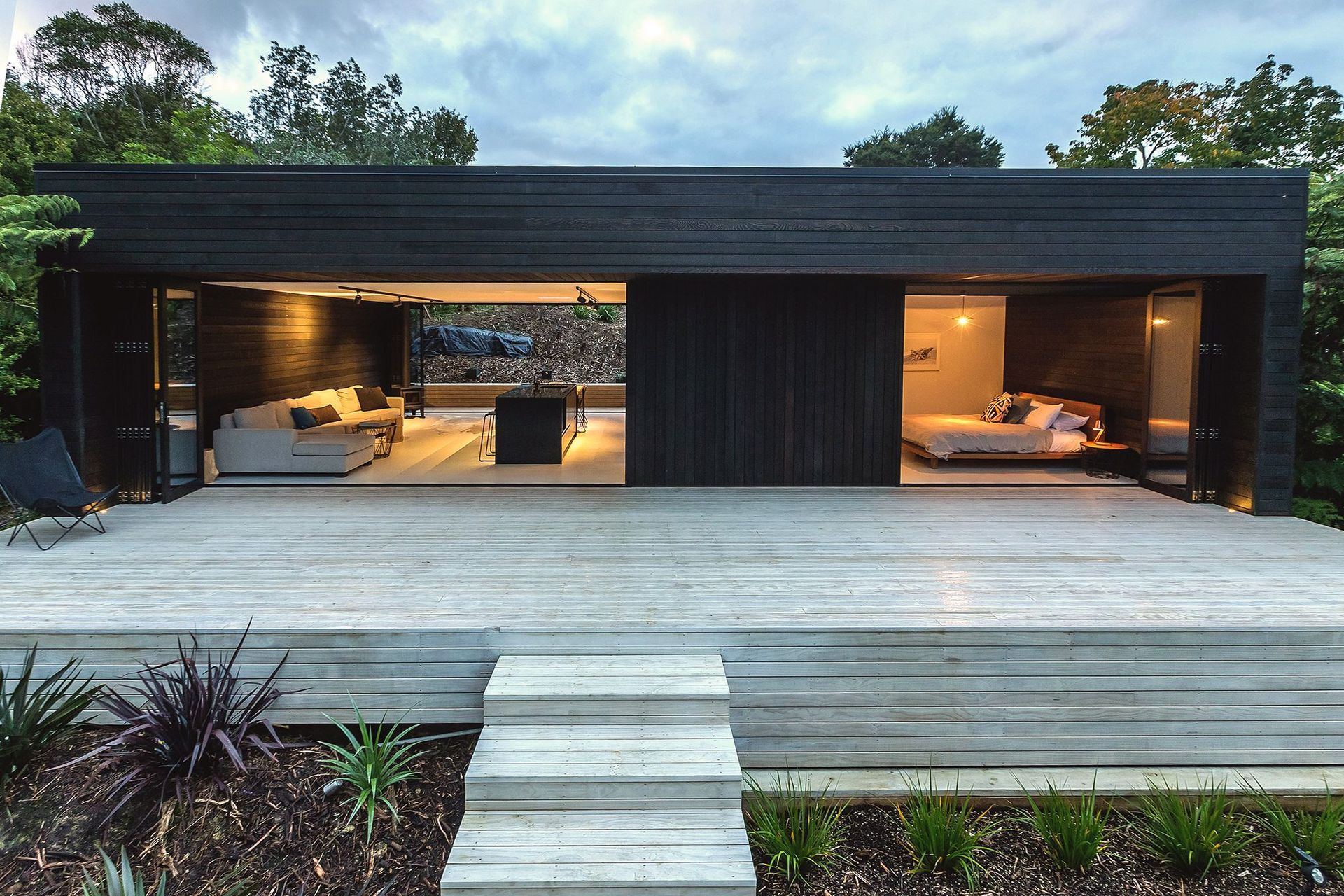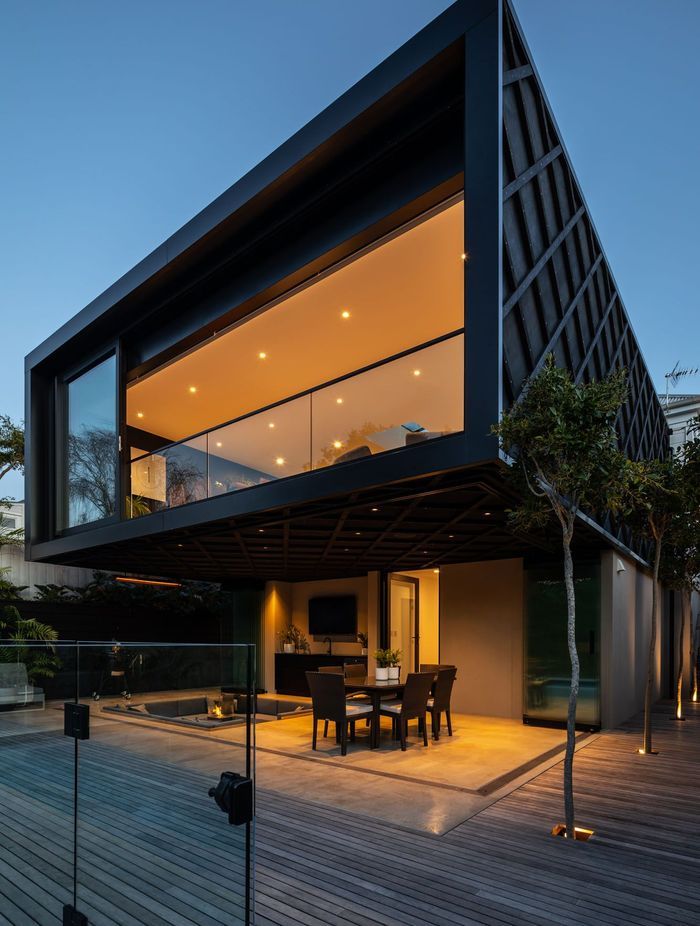Black is the new black
Written by
28 October 2018
•
6 min read

Auckland-based EMA Architecture is known for designing a range of black houses, from a holiday house set in the Waiheke bush to several renovations in the inner city. ArchiPro caught up with director Evelyn McNamara to discuss all things black.
Why do you like using black in your projects?
My design style is based around the idea that the house is a gallery for living. By using black and white you create an amazing blank canvas to dress. Externally, black looks great with the New Zealand bush and natural, earthy colours, whereas, externally, white is hard and urban.
People often think it’s oppressive but black on the exterior is actually recessive as it blends into its surroundings – white doesn’t. I like it because it’s non-offensive, it’s sympathetic, and used on the interior it becomes an amazing canvas.
What have been some technological advancements in using black in architecture?
There has been a lot of criticism of building homes in black and a hesitation to do it. Builders and industry professionals, even homeowners, have said that it gets too hot and the nails pop out, which is why, traditionally, a lot of people have shied away from it. However, the choice to go black has become more powerful and easy with the improved technology of materials, so the use of the colour is now achievable from a performance point of view.
My big shift in using black is I am now using Accoya stained black, which has a 50 year warranty. The EMA House and Grey Lynn renovation were done in cedar, and while that is weathertight, with movement and time it doesn’t last as well, it changes aesthetic and gives a more rustic look.
Do you think black architecture is just having its moment and is a fad?
In the 1960s and ‘70s there was a lot of black with bronze joinery which is coming back a little, it’s a classic. Black, white and grey are timeless, and with the use of those colours it means that you rely on the form to create the interest. A lot of people think the black kitchen is a fad, but the white kitchen is not, and they are no different. Fads, to me, are much more apparent in colour, such as the lime green kitchen or the use of Ayers Rock orange.
Where doesn’t black work?
Right on the coast – absolute beachfront – doesn’t work that well as it’s an unnatural contrast. It’s important to make projects adapt to their surroundings. I would use a more natural timber colour – although if a client really wanted a black home beachfront, I’d suggest a lot of planting around the house. It’s also not great for the black being on the coast, it suits a shady environment. The EMA House, for example, blended in well with the surrounding ponga trunks.
I am currently working on an upcoming house in New Plymouth [render at top of article] that utilises a lot of black and is on the coast, but it’s black sand, so it works there. I always try to get the house to meet its surroundings, this home has Mount Taranaki on one side and rugged coastline and black sand on the other. Black timber and concrete are very much materials of New Plymouth – I wouldn’t choose those materials on a white sand beach up north.
Why are clients asking for black homes?
People do a lot of research on sites like ArchiPro and are inspired by the black houses they see online, plus the improved technology of materials means black is now just as durable as any other colour.
The other element is that concrete has suddenly become quite popular in New Zealand and black and concrete look great together. Concrete has been huge overseas in places like Brazil due to their hot climate but, historically, New Zealand hasn’t done a lot of concrete, we’ve done masonry block and timber houses.
Black and blonde also go very well together, they are still the preferred colour palettes for timber in a modern aesthetic and create the type of clear, crisp gallery-style homes that I enjoy designing.
What are some of the main challenges of working with the colour?
Historically, it was the performance. The ancient Japanese technique of Shou Sugi Ban (surface charred timber) is great, and while it is super durable, fire resistant and enhances waterproofing capabilities, it’s also quite a niche material and is not suitable for every project.
Another challenge is that blacks clash, so you can’t have a range of shades, unlike when you are working with blond timber. It must be the same black or something completely different.
How do you balance light and dark when using black in the interior?
The idea with the EMA House was that the colour made the wing walls go right through the house and the ceiling and floor was white to offset that. You need to use white or very light timbers to break it up. I would never have a black ceiling and I’m also quite against very dark floors, I find them oppressive.
You’ve created quite a few black kitchens, for example in the recent Grey Lynn renovation you completed with Chris Tate. Why do you like this style?
In the Grey Lynn renovation, the black made the kitchen recessive. Initially we had the white undercoat on and the space felt quite small, however as soon as that wall was black it made the room feel twice as big. You play with depth with black on the interior, with other colours they are obviously on one plane, but black on black on black acts like an infinity wall.
The lattice cladding on the Grey Lynn renovation is interesting, what were the design ideas behind that?
Chris Tate and I asked how we could make a modern box on the back that references the linear weatherboards of the regular villa. Originally, we looked at a mesh but we ended up following some of the linework and completely spinning the cladding on its head. The material is cedar-faced plywood with cedar battens, stained black.
Is black easy to keep clean?
Unfortunately nothing hides dirt and scratches completely, a dark bench will show white dust and white will show black. Every material scratches – houses do get beaten up but I believe that just shows its been enjoyed and lived in. I’m not sure I would do a completely black vanity again though, because white toothpaste shows up a lot!
Lastly, what would you advise to clients thinking of building with black?
I would suggest careful consideration of the entire colour palette to ensure that the use of black does not become overpowering. Balance of dark and light is very important too, so if you have black on the interior, using a white ceiling with skylights works well.
Also, when using black colours externally, you need to use the right materials that have the appropriate warranties.
Words by ArchiPro editor Amelia Melbourne-Hayward.


